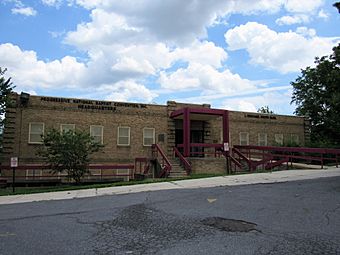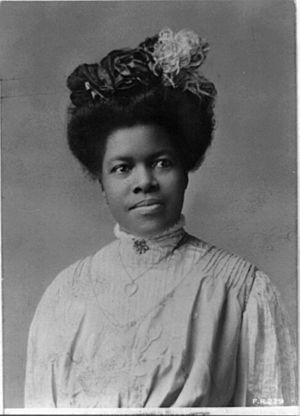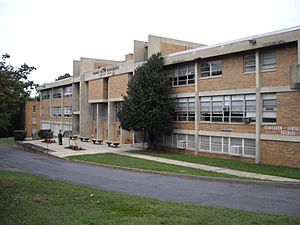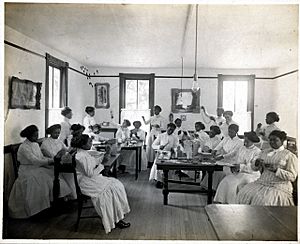Nannie Helen Burroughs School facts for kids
|
Trades Hall of National Training School for Women and Girls
|
|

The 1928 Trades Hall building
|
|
| Location | 601 50th St., NE., Washington, D.C. |
|---|---|
| Area | less than one acre (landmarked area) |
| Architect | Thomas M. Medford |
| Architectural style | Renaissance |
| NRHP reference No. | 91002049 |
Quick facts for kids Significant dates |
|
| Added to NRHP | July 17, 1991 |
| Designated NHL | July 17, 1991 |
The Nannie Helen Burroughs School was a special private school in Washington, D.C.. It was first known as the National Training School for Women and Girls. This school was founded in 1909 by an amazing woman named Nannie Helen Burroughs.
It was the first school in the United States to offer special job training, called vocational training, for African-American girls and women. At that time, many African-American females did not have many chances for education. The school helped them learn skills for jobs and careers. The Trades Hall building, built in 1928, is the oldest building on the campus. It was recognized as a National Historic Landmark in 1991 because of its important history. Today, the property is home to the main offices of the Progressive National Baptist Convention. It also houses the Monroe School, which is a private high school that continues Nannie Helen Burroughs' important work.
Exploring the Campus
The land where the Nannie Helen Burroughs School once stood covers about 6 acres. It is located at the corner of 50th Street NE and Nannie Helen Burroughs Avenue NE. There are four buildings on this hilly campus. The 1928 Trades Hall is the building furthest to the east.
The biggest building on the campus was built in 1971. This building now houses the Monroe School. The historic Trades Hall building is now used for the offices of the Progressive Baptist National Conference. It is a two-story brick building. It was built into a hillside, so it looks like two stories from the front and one story from the back. The building has light-colored bricks with darker bricks used for decoration. A special line of bricks, called a string course, separates the floors. This building was constructed between 1927 and 1928. A famous educator, Mary McLeod Bethune, spoke at its dedication ceremony.
A Look at the School's History
In 1908, Nannie Helen Burroughs started the National Trade and Professional School for Women and Girls. This was one of the very first schools in the country to offer job training for African-American girls and women. The school officially opened its doors on October 19, 1909. Its motto was "We specialize in the wholly impossible."
The school taught skills for home life, called domestic arts, and many different jobs. It also provided religious lessons. It was special because it was the first school to offer all these services in one place. The school also had a stronger focus on regular school subjects than other schools for African Americans at the time. Many other schools focused mostly on job training. The school was supported by the National Baptist Convention. It was also completely funded and managed by African-Americans. Students came to the school from almost every state, Puerto Rico, Haiti, and even from places as far away as South America and Africa.
In the 1920s, the school added even more types of job skills training. It closed for a short time in 1953 but then opened again. Nannie Helen Burroughs led the school until she passed away in 1961. In 1964, the school was renamed in her honor. Today, The Monroe School, Inc. continues her important work. It operates in the 1971 school building on the campus. The original Trade School building, which was the main building for many years, now holds the offices of the Progressive National Baptist Convention.
Famous Alumni
Many talented people attended this school. Here are a few notable alumni:
- Agnes Nebo von Ballmoos – A professor of music, scholar of Liberian folk music, conductor, composer, and lawyer from Liberia.
- Ethel Moses – An actress and dancer.
- Sue Bailey Thurman – An author, lecturer, historian, and civil rights activist.
- Samira Wiley - An actress.
See Also





